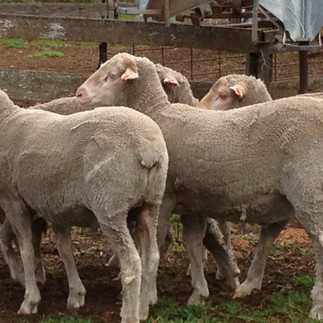Case Study: Notes on managing an unmulesed merino sheep enterprise; evolution not revolution.
- ASHEEP
- Feb 29, 2020
- 3 min read
Updated: Jul 1, 2021
ASHEEP interviews Michael & Helen Palmer, Arrandale Farms

With major retailers David Jones, Country Road Group, Target and Kmart announcing their intention to move away from mulesed wool late last year, the practice was once again brought to the attention of mainstream media and consumers.
So what does the non-mulesed flock look like in our local area? Have you considered or started transitioning?
A number of local farmers are in the process of making the move away from the practice and some have already done so. ASHEEP has been working with AgPro Management to give local producers an opportunity to take part in a supported transition project in collaboration with MLA. Contact ASHEEP to be put in touch with this project.
With the non-mulesing conversation hot at hand, ASHEEP would like to thank Michael and Helen Palmer from Arrandale Farms for taking time to share their experience of managing a non-mulesed flock. The Palmers are based in Jerdacuttup and ceased mulesing in 2008. They now report achieving a breech flystrike rate equivalent to their mulesed flock management system, with 98% of their flock free of breech strike.

The Decision to Stop Mulesing
With the 2010 deadline to ban mulesing approaching, the Palmers thought then, and still believe now, "that it would be better for us to evolve a flystrike management system that did not involve mulesing, so that the welfare of our sheep and the profitability of our sheep enterprise could not be harmed by the political controversy surrounding the issue."
"Given our breeding background and management we believed that the next step in evolving a merino flock that didn’t need mulesing was to actually stop mulesing." From 2008, the Palmers then ceased mulesing their lambs.
Flock Breeding Background Prior to Ceasing Mulesing (2008)
Ewe flock was the product of 20 years selective breeding in an environment conducive to flystrike
Plain sheep (Cranmore genetics), with very low incidence of body strike (<1%, requiring treatment)
Breech strike well managed with mulesing, worm management and tactical preventative chemical treatment (2% requiring treatment, mainly in period immediately before shearing in October)
Rams produced on farm for 8 years prior to ceasing mulesing in 2008, from AI of selected flock ewes (120)
Selection process to lower dag score in ewes and rams in place for 8 years
What has been learnt
In the course of transitioning their flock, the Palmers have gained key insight into the need to carefully integrate all available management tools to prevent breech flystrike; shearing, crutching, worm management, preventative chemical treatment and selective breeding. Following is summary of their learnings and the preventative measures they have implemented.
Shearing & Crutching
Meeting shearing withholding periods for preventative chemicals makes the few weeks prior to shearing a risk period which we have only been able to manage with “bunghole” crutching close (1 month) to shearing. This also improves stain and dag management in the woolshed.
We now shear our ewes, ewes hoggets and rams every six months, except in below average seasons when we have elected not to shear, but crutch, lambing ewes in spring, because the staple length is less than 60mm.
Worm Management
Minimize scouring; worm management has to be good, particularly in young sheep.
Preventative Chemical Treatment
We are using a breech Clik treatment on all sheep post shearing, to provide baseline flystrike protection between shearing and crutching.
Selective Breeding
The breeding progress we had made prior to ceasing mulesing helped, and we have continued to make progress since ceasing mulesing.
Minimize breech wrinkle; target breech wrinkle score 1 sheep, in the absence of mulesing.
Select for low dag score; when selecting flock ewes for breeding cull the ones with the highest dag scores (4,5), in the absence of mulesing.
For our AI ewes and rams we apply higher selection pressure for these traits.
We now make use of ASBVs for breech wrinkle, dag score and FWEC when selecting our AI sires.
Being able to access genetics from breeders who have also ceased mulesing has helped us to improve these traits, without compromising our production traits (fertility, fleece value, carcass weight).
Costs
The Palmers report that managing breech flystrike without mulesing is currently costing them an additional $4.00/adult sheep/annum. This includes extra crutching, chemical treatment and associated handling.
Management outcome:
"We are now achieving a breech flystrike rate equivalent to our mulesed flock management system; 98% of our sheep don’t get breech strike."








